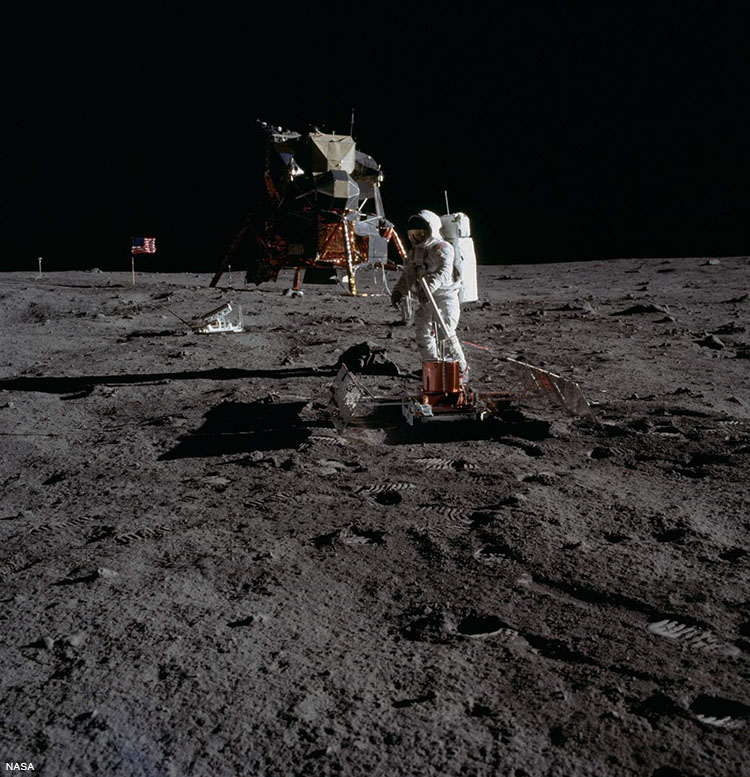Citation: Taylor, G. J. (July 16, 2019) Scientific Discoveries from the Apollo 11 Mission, PSRD, http://www.psrd.hawaii.edu/July19/Apollo11-discoveries.html.
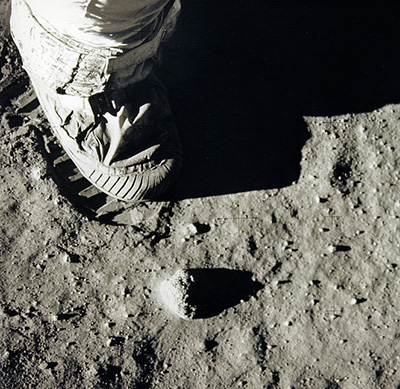
|
July 16, 2019
Scientific Discoveries from the Apollo 11 Mission
--- The Apollo 11 mission showed that the Moon formed hot, that it was magmatically active for at least 800 million years, and that the surface-blanket of dusty rubble contains a treasure trove of evidence of how the Moon formed.
Written by G. Jeffrey Taylor
Hawai‘i Institute of Geophysics and Planetology, University of Hawai‘i
The first human mission to the Moon was a monumental human achievement with vast political ramifications, but it was equally revolutionary in what it taught us about planet formation and the nature of the surface of an airless body. The spacecraft (Eagle) landed on Mare Tranquillitatis. The rocks collected were dominated by unusual (compared to Earth) high-titanium basalt lava flows, not unmelted primitive lunar material as one school of thought claimed. Nor were the maria, as one astronomer alleged, composed of fine-grained dust that accumulated in these low areas, creating deep layers of dust so weak that spacecraft would sink in them. The surface is composed of a blanket of fragments of rocks, minerals from the rocks, breccias (rocky mixtures formed by impacts), and impact-produced glass—rubble we call the regolith. A gigantic surprise was the presence of some rocks unrelated to the basalts. These were composed mostly of the mineral plagioclase feldspar and were interpreted by two investigators as representing the lunar highlands. If correct, they said, it implied that the Moon had been molten when it formed, allowing the plagioclase to float atop a globe-encircling ocean of magma. This was a startling idea because the prevalent pre-Apollo view was that the Moon (and other planets) formed cold. The idea of a substantially molten Moon and the production of magmas in the interior for at least 800 million years indicated a hot origin, changing our perspective on planetary origins.
References:
Apollo 11 Samples, Sampling, and Instruments
Apollo 11 set the stage for continued exploration of the Moon. In a mere two and a half hours, Astronauts Neil Armstrong and Buzz Aldrin collected 21.8 kilograms of rock and regolith, traversed the lunar surface a total distance of ~1–2 kilometers, deployed experiments (notably a seismometer to detect moonquakes, a lunar dust collector, laser-ranging retroreflector, and solar wind collector to determine the composition of the solar wind), and made measurements of the soil mechanics of the surface. The mission successfully demonstrated how humans can explore the Moon and other planetary bodies, and involved big lessons in space suit design, mobility, sampling gear, dealing with dust being kicked up (though not billowing because there is no air), and testing sampling tools.
In recognition of the 50th anniversary of the Apollo 11 landing (July 20, 1969) my focus in this article is on what we learned about the Moon and our Solar System from just this single mission. I list my top three favorite discoveries. This might be a biased view, but these were important discoveries in 1969 and have stood the test of time.

Armstrong said, "The Eagle has landed." He did not say, "OMG, we can't see out the windows because we sank into the dust. Send help!" In truth, few scientists and engineers involved in the Apollo program thought that the lunar surface was so dusty and fluffy that spacecraft would sink through it. But there was this one persistent astronomer, Tommy Gold, a professor at Cornell University. Gold envisioned that fine powder was levitated by electrostatic forces and flowed downhill to accumulate in the lunar maria, making the maria not merely dark, low-lying lava plains, but hazardous dust bowls. The hypothetical thick dust acquired the nickname "Gold dust." Gold always followed his ideas doggedly, and never gave up on them even after Apollo 11 landed safely and Neil and Buzz did not sink up to their knees. They did leave great bootprints, though.
The concept of Gold dust aside, before Apollo 11 landed we did not know with certainty what the surface materials were like on the Moon. Lunar scientists were sure that it would be fragmental because of the impact bombardment that the Moon had clearly suffered. They also knew that the impactors ranged in size from micrometers to tens of kilometers. How dusty the surface material is in this fragmental layer (regolith) can be seen in the clarity of the bootprints. It turns out that about half of the regolith grains are smaller than 60 micrometers in diameter, and 10% are smaller than 10 micrometers in diameter. The broad size distribution plays into the mechanical properties of the regolith, an important measurement first done on the Apollo 11 mission.
A particularly important property of the regolith is that it is fundamentally a rock collection. Essentially all samples collected by the Apollo 11 crew, including fist-sized rock samples, were part of this fragmental layer making up the lunar surface. The rocks came mostly from the bedrock beneath the landing site, but some were flung to the site from distant places as ejecta from impact craters. These traveling rock fragments were the stars of the show when the samples were studied when opened in the Lunar Receiving Laboratory in Houston.

Before the Apollo 11 landing, the prevailing idea was that the Moon and terrestrial planets had formed cold and that the Moon had remained cold and undifferentiated. Harold Urey, Nobel Prize winner for discovering deuterium and basically the founder of cosmochemistry, was a particularly convincing and articulate advocate of a cold Moon. His book The Planets: Their Origin and Development, published in 1952, was a thorough, quantitative look at Solar System formation. The predictions from a cold origin were that lunar rocks ought to resemble chondritic meteorites, unmelted, primitive objects. Cold-origin proponents also predicted that the maria were undifferentiated, perhaps acquiring their dark color by impact processes. Many geologists who had studied Lunar Orbiter images did not agree with this view as there appeared to be flow boundaries like those seen in lava flow fields on Earth. In addition, one of the robotic precursors to the Apollo 11 mission, Surveyor 5, landed in Mare Tranquillitatis. It carried a device called an alpha particle scattering instrument to measure chemical composition of the regolith, finding that it was roughly basaltic in composition, nothing like a chondritic meteorite. Nevertheless, the idea of a cold, undifferentiated Moon held sway. Until Apollo 11 brought back some regolith.
The photo below shows a little bucket of rocks 1–5 millimeter in size from the large Apollo 11 regolith sample (sample 10084 for those keeping score). It consists of rock, mineral, and glass fragments. The sample pictured was studied by John A. Wood and colleagues at the Smithsonian Astrophysical Observatory in Cambridge, Massachusetts (now called the Harvard-Smithsonian Center for Astrophysics). Wood and colleagues described the rock types present in this tablespoonful of lunar regolith, reporting fragments of basalt (surprisingly high in titanium), breccias (impact-produced mixtures of rock and mineral fragments), impact spherules (glass), and irregularly-shaped agglutinates. Most important, they found a few (61 of the 1676 particles they examined) were drastically differently. These particles (white in color) are rich in plagioclase feldspar, averaging more than 75% plagioclase (some almost nothing but plagioclase). The mare basalt fragments contained only 30–35% plagioclase.
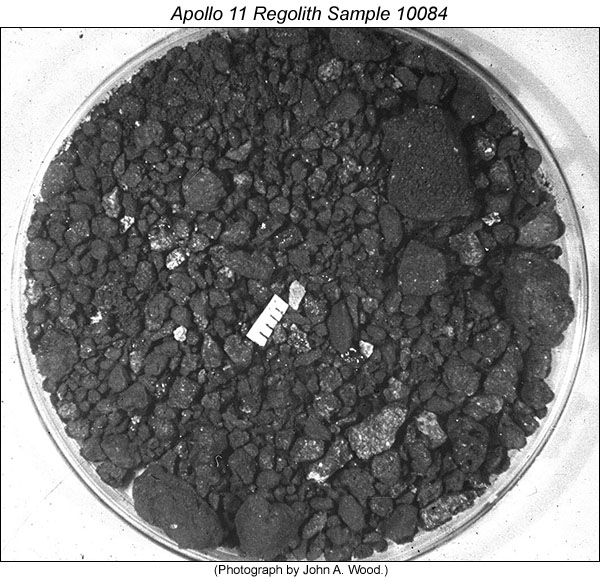 |
| Photograph of the lunar regolith studied by John Wood and coworkers. Sample was sieved so particles are in the 1 millimeter to 5 millimeter size range (see scale bar). Dark fragments are mostly mare basalts and breccias formed by impacts into the Apollo 11 regolith. The few white particles visible are rich in plagioclase feldspar, and clearly represent a different rock type than the abundant mare basalts. Wood suggested that the plagioclase-feldspar-rich fragments were transported to the Apollo 11 landing site from the lunar highlands by impacts over billions of years. |
 |
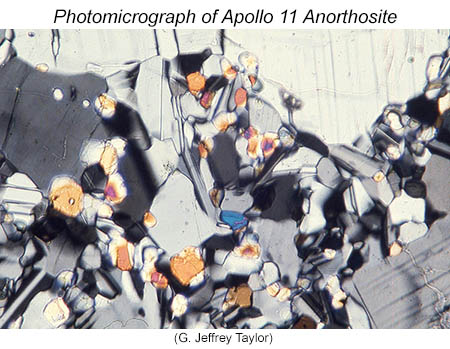 |
| [LEFT] John A. Wood, photographed in the early 1970s. [RIGHT] Photomicrograph, 625 micrometers across, in polarized light of a thin slice of one of the plagioclase-feldspar-rich particles studied by John Wood and team. View shows mostly plagioclase feldspar (light gray to dark gray) and small grains of olivine and pyroxene (orange, reddish, and blue). | |
The existence of plagioclase-feldspar-rich rocks was a surprise to everyone. Such rocks are called anorthosite if they contain more than 90% plagioclase; they are called gabbroic anorthosite if they contain 77-89% plagioclase. It was clear that these light-colored rocks were not like the lava flows beneath the Mare Tranquillitatis regolith. Wood reasoned that they must have been delivered to the site by impacts on nearby highlands, suggesting that those highlands were composed of anorthosite and related rocks. Possessing an imposing imagination and a bold streak, he suggested that ALL the highlands were composed of anorthosite. He also noted the similarity in chemical composition between the Apollo 11 feldspar-rich rocks (determined by electron microprobe analysis) and the composition of the ejecta blanket on the highlands crater Tycho, as determined by a chemical analyzer carried on the Surveyor 5 robotic lander.
The lunar highlands are heavily cratered, so Wood proposed that the anorthosite layer could be 10 kilometers thick. How do you make so much rock composed of a mineral that forms in magma? There really is only one way: it has to accumulate as a magma system crystallizes. We see this in big igneous bodies on Earth. Called layered igneous intrusions, they contain large layers of anorthosite. Plagioclase can be separated from other minerals in a magma because it is less dense that other major minerals (olivine, pyroxene) and can be less dense than the magma, depending on the composition of the magma. So, using the well-established understanding of magma crystallization, Wood proposed that the plagioclase feldspar formed by accumulation in magma. Good idea, but not enough for John Wood. Assuming that the highlands were mostly anorthosite, he argued that the magma body was a globe-encircling magma system, eventually called the "magma ocean." (See references below for the first use of the term.)
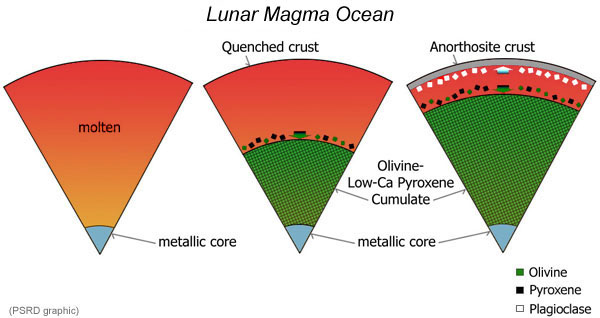 |
| The idea that the Moon melted substantially (probably completely) when it formed, nicknamed the magma ocean concept, is an important theory in lunar and planetary science. These three panels, from left to right, illustrate the concept. The basic idea is that as the molten Moon (left) crystallized (center and right), minerals less dense than the magma floated and the heavier ones sank. The lighter minerals (plagioclase) formed the primary crust of the Moon. |
The idea of the magma ocean and the massive melting it required demolished the cold-accretion idea. The Moon was a differentiated object that underwent a massive melting event to make the anorthosite crust. If it started out like a chondritic meteorite, it did not stay that way. Elements are rearranged, a little metallic core formed, a big anorthosite crust accumulated.
Wood and co-workers were joined in suggesting a plagioclase-feldspar-rich highlands and massive melting of the Moon by J. V. Smith and colleagues at the University of Chicago. An interesting difference in their approaches was that Wood and colleagues honed in on the anorthosites while giving somewhat cursory mention of the other rocks present, showing Wood's interest in breaking completely new ground. Nevertheless, both developed a bold idea that has stood the test of time (at least so far).

Another part of the cold-Moon idea was that the lunar maria would be composed of primitive materials, not igneous lava flows. The Apollo 11 samples ensured the demise of the cold, undifferentiated Moon. The most abundant samples, which surely represent those right under the landing site, were clearly basaltic rocks. They were interesting in that they contained much more titanium and less aluminum (hence less plagioclase feldspar) than most Earth basalts, but their textures (the way minerals are intergrown) were clearly igneous and consistent with crystallization in a lava flow. Laboratory experiments confirmed that the textures could be produced at cooling rates (degrees Celsius per hour) appropriate for lava flows.
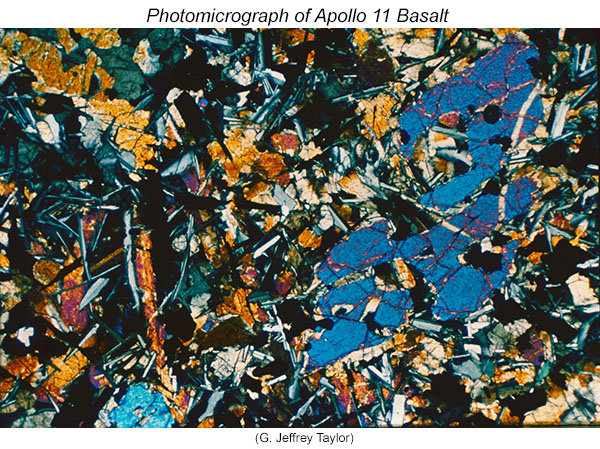 |
| Photomicrograph in polarized light of a thin section (~46x27 millimeters) of a lunar basalt. Large blue crystal is olivine, elongate gray grains are plagioclase, orange are pyroxene, and most of the black grains are ilmenite (iron-titanium oxide). The shapes and the way the grains are intergrown are diagnostic of crystallization in lava flows. By analogy, everyone assumed that the rest of the maria were also composed of basaltic lava flows. |
Isotopic-dating analyses showed that the Apollo 11 basalts had ages of 3.7 billion years, providing further proof of an extended igneous differentiation of the Moon. Experiments indicated that when the lavas erupted, they were more fluid (lower viscosity) than typical terrestrial basalts. This has implications for their emplacement on the lunar surface. A particularly interesting feature of the lunar basalts is that they formed under much less oxidizing conditions than do terrestrial basalts. There is essentially no ferric iron (Fe3+) in the rocks; in fact, little droplets of metallic iron precipitate near the end of mare basalt crystallization. This reflects a general property of the lunar interior that we learned for the first time from Apollo 11.
Apollo 11, The Beginning
The Apollo 11 mission showed that the Moon differentiated early and was magmatically active at least until 3.7 billion years ago. (Additional Apollo samples and lunar meteorites indicate igneous activity as recently as about a billion years ago.) Planets did not form cold. The magma ocean idea has been routinely extended to other terrestrial planets and even large asteroids. And this was only the beginning of discoveries from NASA's Apollo program, as detailed in numerous PSRD articles over the years [see PSRD archive of Moon articles]. Not mentioned above is one additional (non-)discovery from Apollo 11: we found no evidence for life, in spite of an extensive search. On the other hand, Apollo 11 showed that humans can explore another world effectively, and that we could also inhabit it. Perhaps that absence of evidence for life on the Moon is only a temporary situation.
First papers on magma ocean concept:
- Smith, J. V., Anderson, A. T., Newton, R. C., Olsen, E. J., Wyllie, P. J., Crewe, A. V., Isaacson, M. S., and Johnson, D. (1970) Petrologic History of the Moon Inferred from Petrography, Mineralogy, and Petrogenesis of Apollo 11 Rocks. Proceedings of the Apollo 11 Lunar Science Conference, v. 1, p. 897-925. [read]
- Wood, John A., Dickey, John S., Jr., Marvin, Ursula B., and Powell, Benjamin N. (1970) Lunar anorthosites. Science, v.167, p. 602-604, doi: 10.1126/science.167.3918.602. [read abstract]
- Wood, John A., Dickey, John S., Jr., Marvin, Ursula B., and Powell, Benjamin N. (1970) Lunar Anorthosites and a Geophysical Model of the Moon. Proceedings of the Apollo 11 Lunar Science Conference, v. 1, p. 965-988. [read]
First use of the term magma ocean:
- Walker, D., Longhi, J., and Hays, J. F. (1975) Differentiation of a Very Thick Magma Body. Proceedings of the 6th Lunar Science Conference, v. 1, p. 838-840. [read]
- Walker, D., Longhi, J., and Hays, J. F. (1975) Differentiation of a Very Thick Magma Body and Implications for the Source Region of Mare Basalts. Proceedings of the 6th Lunar Science Conference, v. 1, p. 1103-1120. [read]
- Wood, J. A. (1975) Lunar Petrogenesis in a Well-stirred Magma Ocean. Abstracts of the 6th Lunar Science Conference, p. 881-883. [read]
- Wood, J. A. (1975) Lunar Petrogenesis in a Well-stirred Magma Ocean. Proceedings of the 6th Lunar Science Conference, v. 1, p. 1087-1102. [read]
See also:
- Apollo 11 Landing: Simulation, using LROC photographs, of what Astronaut Neil Armstrong saw out his window while Lunar Module Eagle approached the surface and landed, from the Lunar Reconnaissance Orbiter Camera (LROC) team.
- Apollo Legacy and NASA's Leap into the Future. This NASA site includes a slide set available for downloading, from NASA Goddard Space Flight Center.
- Lunar Receiving Laboratory description from NASA with video of archival footage.
- Lunar Curation. All about the lunar rocks and regolith samples from NASA's Apollo Missions, from NASA Astromaterials Research & Exploration Science Office.
- The Lunar Sample Compendium. Comprehensive database from NASA Astromaterials Research & Exploration Science Office.
- Urey, H. C. (1952) The Planets: Their Origin and Development. Yale University Press, New Haven, 245 pages.
|
|
[ About PSRD | Archive | CosmoSparks | Search | Subscribe ] [ Glossary | General Resources | Comments | Top of page ] |

